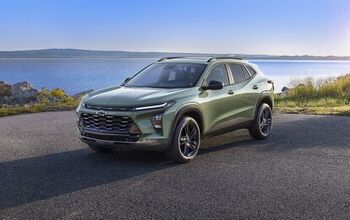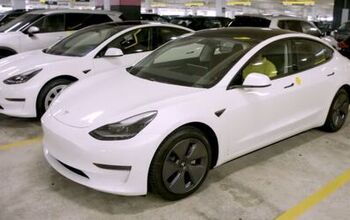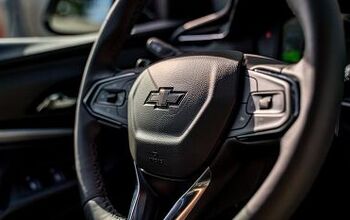2019 Jaguar I-Pace EV400 HSE Review - EV Growing Pains Persist

2019 Jaguar I-Pace EV400 HSE Fast Facts
Jaguar’s I-Pace electric hatchback provides an interesting driving experience. When it has enough charge to be driven, that is.
The I-Pace I drove for a weekend last summer spent much of that time at the dealership, charging, because it failed to charge anywhere else near my home.
More on that in a minute.
Background, for those that don’t know: The I-Pace is an all-electric small hatchback that uses a 90 kWh battery to offer a claimed range of up to 234 miles. Jaguar also promises an 80 percent charge in 40 minutes using a fast charger, but again, more on that later.
The I-Pace’s twin electric motors (one front, one rear) pump out 394 horsepower and 512 lb-ft of torque combined, which gets to the 20-inch wheels via an all-wheel-drive system and a single-speed automatic transmission.
On road, the driving experience is standard EV – instant torque, whirring and whooshing replacing engine noise, single-pedal driving with regenerative braking, et cetera. For those unfamiliar with that last bit, that means lifting off the gas actually slows the vehicle and provides some regen, as opposed to simply just coasting. You’ll still use the brakes in most situations, though.
[Get new and used Jaguar I-Pace pricing here!]
Even the nav system is in on the act – it can factor in your driving style and other elements to choose a route that optimizes range.
That all sounds gee-whiz great, but the fact is, the I-Pace was difficult to charge, and Jaguar couldn’t tell me why – there was nothing obviously wrong with my test car.
I knew from jump I’d not be able to do much charging at home – the outlets in the parking garage of my condo couldn’t provide enough juice, even overnight, for more than a few miles of charge.
No worries – a Whole Foods close to my house had the proper chargers. Just drop the I-Pace, lock it, and come back later. Done.
Except not so simple. The I-Pace wouldn’t take a charge from either unit on site. Nor did it take a charge from the units located a Walgreen’s. Hmmm.
I consulted with JLR PR and was told to make sure the car was locked – it won’t charge if you try to get it going before locking the doors. Okay. I tried that, still no juice. At this point, I was advised that perhaps a pin in the plug of the charging cord had been bent by a previous journo. Apparently, sometimes the plug doesn’t come loose easily after a charge, and a user forces the issue and bends a pin.
That explanation made sense, but no pins appeared bent.
I finally threw up my hands and trekked to the local Jag dealership. The folks there got it to plug in and charge no problem. Now I felt like an idiot.
After recharging, I drove the hour or so to my dad’s house to pick him up for a planned drive to Wisconsin (this was during pre-pandemic times), and we decided to take his car – the math on the remaining range wasn’t good, not if I wanted to return home the next day. I tried a standard outdoor outlet at his place, and all I managed to do was blow a fuse.
It wasn’t until my last day with the car, on the third or fourth visit to my neighborhood Whole Foods, that one of the two charging units finally provided a charge. Yet the car’s dash never showed the readout it was supposed to while charging.
Upon further inquiry with JLR, the best guess was that somehow the car and charging units weren’t “talking” to each other correctly, although that doesn’t necessarily explain why the proper screen didn’t appear.
If you haven’t already done so, this is a good place to get the British/Lucas/Jaguar electronics jokes off your chest.
Charging issues aside, I found the I-Pace delightfully funky. The handling does suffer a bit from the hatch’s odd proportions, but only a bit. There’s enough sportiness on tap to counter the worst myths about EVs, and the air-suspension ride is acceptable for long freeway stints.
I generally liked the interior, which integrates infotainment and HVAC display screens nicely (you can also call up nav in the gauge cluster), although like with all current Jaguar interiors, I worry about the possible long-term repairs costs of these tech-focused cabins.
The hatch’s looks are of the “tall yet sleek” variety, and while it can look odd from certain angles, it’s also fairly cohesive as an overall package.
While the I-Pace is EV-only and the platform likely can’t accommodate any other type of powerplant, I found myself wondering how fun the I-Pace could be as an entry-level crossover with a petrol turbo-four under hood and a traditional automatic transmission. Instead, it’s a quite pricey luxury EV.
I’m not kidding. The base price on this bad boy was over $80,500. That price includes premium LED headlights, fixed panoramic roof, powered/gesture-activated tailgate, leather seats, dual-zone climate control, heated and cooled front seats, keyless entry and starting, premium audio, satellite radio, Bluetooth, USB, Apple CarPlay, Android Auto, lane-keep assist, traffic-sign recognition, adaptive speed limiter, 360-degree parking aid, clear exit monitor, adaptive cruise control, high-speed emergency braking, blind-spot assist, and 360-degree camera.
A $2,200 package included a head-up display and configurable ambient lighting, among other things, and additional options included a heated steering wheel, a heated windshield, and even heated washer jets. All told, the final tally was $86,771.
Also an option: Adaptive dynamics, which allows drivers to customize their drive modes.
The I-Pace is one of a new breed of BEVs that sheds the electric-car-as-penalty-box label. The problem here is that EV charging can still be a challenge – not everyone can charge at home, and if chargers in public lots don’t work or are occupied, tough luck. Speaking of luck, maybe it’s me – I nearly killed a Leaf at a previous gig.
Price will be an issue, too. This is not the EV for the everyman. Live in the right place, have the right sized bank account, and maybe the I-Pace will work for you. For the rest of us, it’s a neat little EV hatch that remains a novelty, for now.
[Images © 2020 Tim Healey/TTAC]

Tim Healey grew up around the auto-parts business and has always had a love for cars — his parents joke his first word was “‘Vette”. Despite this, he wanted to pursue a career in sports writing but he ended up falling semi-accidentally into the automotive-journalism industry, first at Consumer Guide Automotive and later at Web2Carz.com. He also worked as an industry analyst at Mintel Group and freelanced for About.com, CarFax, Vehix.com, High Gear Media, Torque News, FutureCar.com, Cars.com, among others, and of course Vertical Scope sites such as AutoGuide.com, Off-Road.com, and HybridCars.com. He’s an urbanite and as such, doesn’t need a daily driver, but if he had one, it would be compact, sporty, and have a manual transmission.
More by Tim Healey
Latest Car Reviews
Read moreLatest Product Reviews
Read moreRecent Comments
- Daniel J How is this different than a fully lifted truck? I see trucks rolling off the lot with the back lifted already, and then folks get the front lifted to match. Are there specific "metrics" at how high they can and can't be? The example shown has the truck's front lifted more than normal, but I've seen these around here where the backend is dropped and the front end is at a regular height.
- Theflyersfan I think color is FINALLY starting to return to car lots. After what seems like over a lost decade of nothing but shades of gray, whites, and black, I'm seeing a lot more reds and blues creeping into luxury car lots. Except Audi and Volvo. They still have at least 6-8 shades of gray/silver. But they at least have a nice green. Honda and Acura seem to have a bunch of new colors. And all carmakers need to take a serious look at the shades of red seen at the Alfa Romeo lot and tell themselves they want that because that looks amazing.
- Bd2 Well, it's no Sonata, no does it have the panache of the Optima.
- Teddyc73 "eye-searingly"?
- Teddyc73 I applaud anyone who purchases a vibrant, distinct or less popular color. We need these people. Our road ways have turned into a dreary gloomy sea of white, black, silver and greys, most with the equally lifeless black wheels. Mr Healey is guilty of contributing to this gloom apparently. It looks like a black and white movie across the nation when grouped with our grey houses with grey interiors. Totally dull and lifeless. And what is with this awful hideous trend of dull grey with black wheels showing up everywhere? It's on everything. Just awful. Come on people! I'll keep my Ram 1500 with it's deep rich sparkling Western Brown paint as long as I can.






































Comments
Join the conversation
I got a ride around the Nurburgring in one of these, in the wet, with their powertrain development engineer. Ho-lee-crap. For a bone stock vehicle with 4 people on board, it was amazing. He was able to balance between over and understeer both on corner entry and power-on corner exit. Yeah, the suspension needed more body control for track duty, but it handled it. I think the ride in the wet, with someone who had probably a thousand laps there, was better than if it'd been dry (for this vehicle).
A number of years ago, Cadillac offered a version of the Volt called the ELR. It was totally fine. But it was priced as the most expensive Cadillac on the lot and failed very quickly because it wasn't the best Cadillac on the lot. In fact, it may have been the least desirable Cadillac wearing the highest MSRP. So in some ways the I-Pace reminds me of the ELR. It may be fine. It may pack some nice tech. But it's the least attractive Jaguar. It may have the least luxurious interior. And this review is correct to wonder "how fun the I-Pace could be as an entry-level crossover," so it really doesn't score high in the exclusivity or desirability departments. With all that, the I-Pace is the most expensive Jaguar. It should be priced a little higher than the XE but they've priced it higher than the XJ. This is wrong.